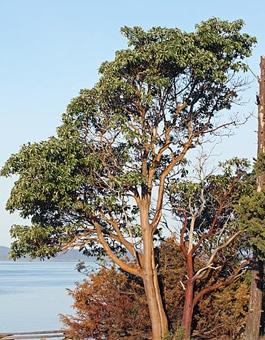

The broadleaf imitator
The Pacific madrone is a gorgeous, unique tree. It is an evergreen with broadleaf, leathery, thick leaves that last throughout the winter. The wood is hard and valuable for woodworking, but tends to warp and check as it dries. Native Americans used the berries for chewing and cider.
Range
It is found widely across the western Willamette Valley and in southern Oregon, on well-drained, sunny sites. It is native to the West Coast and occurs from the coast ranges of British Columbia down to California.
Character
An evergreen broadleaf tree up to 100 feet tall. The bark has a distinctive reddish-brown color and peels in the fall, exposing green flesh underneath. Flowers are showy clusters of pink and white. The reddish-orange fruit is pea-size with a pebbly texture.
Understory
The red orange berries are popular in the fall with quail, robins, bears and raccoons. Bees like the flower clusters in spring.
Climate
Pacific madrone loves humid coastal sites, as well as foothill areas with dry summers and mild winters.
Management
In coniferous timber areas, Pacific madrone is considered “weedy” and is usually controlled. Madrone is a vigorous stump sprouter and often forms multiple stem sprout clumps after a tree is cut. The clumps need to be thinned to the one good stem if madrone sawlogs are the goal.